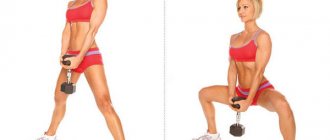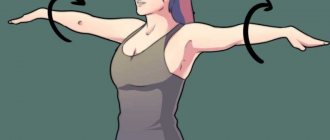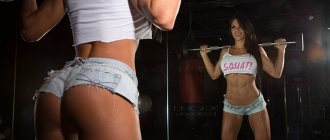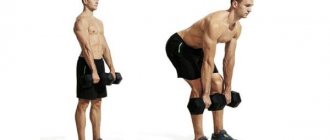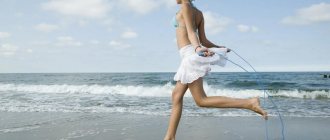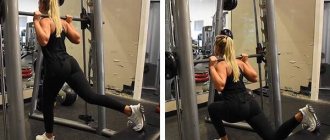Plie squats technique
The plie squat can be performed in different ways - the technique will vary. If this is your first workout in the gym, don’t rush to do plie squats with dumbbells right away, start with something simple.
Bodyweight plie
This plie squat is recommended for beginners or girls who want to make their buttocks more elastic.
- Spread your legs wide, turn your toes as far as possible, they should point in different directions. Keep your head and back straight and place your hands on your waist. Hands can also be kept “locked” at chest level.
- Take a deep breath and sit down. The line of the hips should be parallel to the floor, and the knees should be perpendicular to the feet. Hold the position for a few seconds.
- Exhale and come back without straightening your legs completely. Do the required number of times.
For those who feel more confident, it is recommended to perform an exercise with a weight, for example, squats with a plate or barbell. Squatting with dumbbells between your legs will create additional stress on your leg muscles and make your workout more effective.
Plie squat with dumbbells or kettlebell
The optimal weight for girls when performing plie with dumbbells is considered to be 3–8 kg. The technique is quite similar to the technique of squats without weights. The only difference between a plié and a dumbbell is that the apparatus must be held between the legs with outstretched arms. An alternative weighting agent at home can be a bottle of water or a couple of thick books from the library.
Plie with dumbbells
When performing this version of the exercise, you will need two dumbbells, each weighing at least 2.5 kg. Hold dumbbells at chest level and perform the exercise as described above.
The more the socks are turned out, the more the load goes on the inner thighs
It is also very important not to rush and perform all movements smoothly. Weights should be between your legs perpendicular to the floor
advertising is not displayed
Analysis of the exercise
The target muscles of the dumbbell plie squat are:
The quadriceps and hamstrings work to a lesser extent. Stabilizing work is performed by the extensor spine, abs, quadratus lumborum and calf muscles.
Preparing for the exercise
The plie squat with a dumbbell will require you to get a good stretch. After all, the wider you place your legs and turn your feet, the better the adductor muscles will work. Therefore, stretching and warming up the leg muscles is necessary. You should begin the approach without weight before using weights.
Differences between plie squats with dumbbells and sumo squats
The main difference between these two exercises is the position of the body during movement. In terms of load, sumo puts more stress on the buttocks, and plie puts more stress on the inner thigh.
Recommendations for implementation
The plie squat with dumbbells is the best exercise option for an experienced athlete - it allows you to significantly increase the intensity of the load compared to squats without weights and at the same time eliminate the traumatic pressure on the spine that occurs when holding the apparatus on the trapezius in the case of a barbell.
Proper technique is the key to successful training for any exercise. The main thing is not how much you lift and how many times, but how you do it. Therefore, follow these rules for the technique of performing plie squats with dumbbells:
Inclusion in training
Dumbbell plie should be performed at the beginning of the workout or in the middle, after a good warm-up. Perform 10-15 repetitions for 3-4 sets.
How to technically perform plie squats?
Execution technique is the most important point. Its strict execution and compliance guarantees maximum results and no injuries. It is recommended to perform the exercise with minimal weight or no apparatus at all. In general, you can perform plie squats:
- with a barbell,
- dumbbells,
- weights,
- any other burden.
Which makes it possible to perform it at home.
Before learning how to do a plie squat correctly, it is recommended to prepare for the exercise. It can be used as a main one at the beginning of a workout or as an additional one in the middle. It all depends directly on the goals of the trainee. Before starting the exercise, it is recommended:
- Stretching. Since you need to squat deeply, you need to warm up your muscles well to avoid injury.
- Comfortable equipment. Clothes should not restrict movement, and shoes must have hard soles.
A few words about stretching. The main points are the ligaments and tendons of the inner and posterior thighs. It is best to give them time to stretch so that they are more elastic during the squat.
- For the lower back, you can use hyperextension, as well as the well-known exercise - reaching with your hands to the floor.
- You can stretch your legs on the wall bars. We stretch as if we were trying to do the splits.
And now the plie technique itself:
- Starting position. Place your feet slightly wider than your shoulders. Socks should point in different directions (as much as possible). There is a projectile in your hands or behind your head/on your shoulders/in front of you. If your hands are empty, then we place them on the belt. The head is level, the gaze is directed forward, the back and lower back are straight.
- Inhale: Lower yourself down, as with classic squats, moving your pelvis back and bending your knees. The hip line should be parallel to the floor and form a 90-degree angle at the knee. The knees should be directed towards the feet, not going beyond them.
- Exhale: At the lowest point you need to linger for one or two seconds. Then we take the initial position.
Squat technique
You can squat on both legs, on one, with support, with weight, with arms raised: this is not a complete list of ways to perform the exercise. Despite the differences in execution, all types of techniques have similar biomechanics. So, more about the technique of doing squats.
General biomechanics
In general, the squat technique looks like this:
- Place your feet shoulder-width apart. Position your feet so that your toes are slightly turned out to the sides.
- Point your knees and toes in one direction. Shift your body weight to your heels.
- Press your feet firmly to the floor and do not lift them throughout the entire exercise.
- If you are performing a squat without additional weights, you can hold your hands in front of you (this is the easiest way to maintain balance), put them behind your head, or cross them in front of your chest.
- Keep your lower back in a “boat” position with a slight arch. Do not round it, including in the thoracic region.
- Try not to lean forward. Watch your posture.
- Do not bring your knees in or spread them out to the sides when rising from a low position. The knees should “look” in the same direction as the feet. Also try not to bring your knees forward beyond the level of your toes.
- Take a deep breath at the beginning of the exercise. In the future, when rising, you need to exhale, when lowering, inhale.
- You need to lower yourself at least until your thighs are parallel to the floor. Even deeper is better, although this depends on the purpose of the exercise.
- There is no need to straighten your legs all the way at the top point. Just before reaching full straightening, immediately begin moving downwards.
Equipment
Additional equipment is needed for squats with weights (dumbbells, kettlebells, barbells).
For strength training we use:
- Elastic bandages for knee and wrist joints.
- Belt.
- Special overalls for squats (used only in competitive powerlifting).
Powerlifting overalls are used only in conjunction with bandages. They prevent you from bending your back while squatting with weights. The cut of the legs helps to start the upward movement from the lowest point. The overalls can increase the result in squats by tens of kilograms.

concept w - stock.adobe.com
To perform squats in a gymnastics complex for pregnant women or as part of physical rehabilitation after injuries to the spine or limbs, a gymnastic pole (stick) is used to reduce the load. The athlete places it vertically in front of him and uses it as a support.
To perform Bulgarian squats, you need a bench or other support. Leaning into it with the toe of your outstretched leg, you need to squat down so that the thigh of your supporting leg is parallel to the floor.
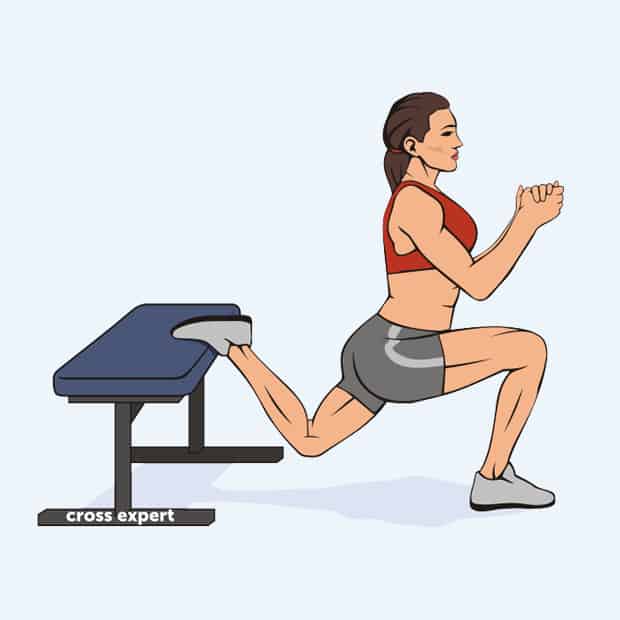
Classic execution
This exercise works the gluteal muscles, biceps and quadriceps. It is suitable for all athletes, regardless of gender. So, how to perform the classic version of squats with dumbbells between your legs:
Pick up a dumbbell with a suitable weight. Place your feet shoulder-width apart, lift your chin slightly and push your butt back. As you exhale, lower yourself, trying to lean on your heels
At this moment, it is important not to slouch or arch your back. For maximum results, squat as deep as possible
It is advisable to touch the dumbbell to the floor. Hold this position for 1-2 seconds, then slowly rise up, exhaling.
There are many varieties of the classic squat for girls and boys. You will get acquainted with the technique of performing some of them below. To achieve maximum results and diversify your workouts, perform several types of squats in one workout.

Top 7 squats for the gluteal muscles and technique for performing them
There are many different sets of squats for the formation of beautiful and elastic buttocks.
When choosing a training program for yourself, be sure to pay attention to whether it is right for you. Classes are selected individually for each person
In this case, various factors are taken into account - general health, level of physical development, psycho-emotional state.
Classic
The classic glute squat technique engages all the leg muscles and gluteal muscles.
- Starting position – back straight, feet hip-width apart, arms freely positioned along the body.
- As you exhale, move your pelvis back, squat slowly until a right angle is formed. The thighs are parallel to the floor.
- We return to the starting position, relax while inhaling.
There is also a static version of this movement - it is called “Chair against the wall”
Watch the video for more details:
Deep
Deep squats for the buttocks are very effective, but place a lot of stress on the knee joints. This exercise lowers your hips below your knees.
For more details, watch the video:
Carefully! It is advisable to perform it under the guidance of an instructor, otherwise you may injure your knees
With narrow feet
When performing the exercise, the gluteus maximus and quadriceps muscles take on the main load.
- Starting position – back straight, feet together, arms down along the body, or in front of you, as shown in the picture.
- We perform it like a regular squat.
For detailed techniques, watch the video:
Note! Another very effective exercise is walking on your buttocks. In combination with squats, together they will give incredible results.
Besides getting rid of cellulite, butt walking has many other benefits - 9 Incredible Facts About Butt Walking.
The muscles of the legs and buttocks are well worked out, and fat is removed from the inner thigh. We perform it in the same way as a regular squat.
The difference is that the stance of the legs is wider, and the arms are usually weighed down with dumbbells.
Shown more clearly below:
The gluteal muscles and quadriceps femoris are worked.
- Starting position – back straight, feet shoulder-width apart, toes turned outward, hands on the belt.
- We carry out according to the standard scheme.
More details in the video:
"Curtsy"
All three gluteal muscles are involved in the exercise; this type of squat contributes to their good development. Effectively removes “ears” on the thighs.
- We stand straight, back straight. One leg is in front, the other is behind, resting on the toe.
- We squat smoothly, bending our knees. We keep the body weight on the front leg. Slowly return to the starting position.
Using weights
As you adapt to the loads, all types of glute squats can be done with different loads. These can be dumbbells, barbells, or, at home, plastic bottles filled with water.
- Starting position - stand straight, do not slouch, feet shoulder-width apart.
- We hold a kettlebell or dumbbells with both hands, bent at the elbow joints. Elbows pressed to the sides.
- Smoothly squat using any technology described above.
You can use water bottles or dumbbells. Feet shoulder-width apart, heels firmly on the floor. Your arms can be extended in front of you or lowered down.
Carefully! Contraindications to exercise are some heart and vascular diseases, arthritis, fever, high blood pressure. It is best to consult a doctor
Muscle training
If you master the correct technique for classic squats without weights, you can solve the problem with training your legs. The number of muscles that are used when squatting makes the squat the most effective for tightening and improving the appearance of the legs. This exercise is indispensable for building muscle mass. If necessary, you can move away from the classic type of squat towards plie or sumo. Many people use this exercise as a warm-up for subsequent work with the barbell. It is up to you to decide which muscles will be involved in your activity.
When completing the task of pumping up the quadriceps, hip adductors, calf and gluteal muscles, it is recommended to choose a classic squat with a barbell or bodybar. The hamstrings act as a stabilizer, while the extensor muscles of the back and abs receive a good workout. With legs set wide apart, the inner thighs are actively worked out. To add detail to the outer surface, place your feet closer together. A shallow squat works for relief. All lower muscles are used when squatting, so slight deviations from proper technique will lead to injury in the future.
To build muscle mass in your legs, you need to squat as deeply as possible, bringing your buttocks parallel to the floor. If you use weights, you will be able to increase mass in the hips and buttocks. Exercise has a beneficial effect on blood circulation, metabolism and testosterone release. Regardless of your training goals, it's best to perform a set of squats to avoid over-stressing a specific muscle and achieve a balanced, toned look.
Experts recommend that athletes who experience certain problems with the hip joint try squatting while in the water. This reduces pressure on the joint and allows you to stress the muscles without compromising your health. To achieve hip relief, you need to monitor the squat angle; it should not be more or less than 90°.
What muscles are involved?
Despite the fact that the exercise is used mainly to work the buttocks, many other muscle groups are activated to perform it.
The adductor muscles of the thigh take on the largest share of the load - they are in constant tension from the moment of descent down to the rise back to the starting position.
In addition, the gluteal muscles, quadriceps and hamstrings are directly involved in the movement. Roughly speaking, all leg muscles are involved in the movement, including the calf muscles.
But this exercise is also good because squats with a kettlebell between the legs, or a dumbbell, additionally engages the muscles of the back and arms, creating an isometric load for them.
The core and lower back muscles are essential for maintaining proper upper body position during a squat.
Exercise technique
The most important thing is to learn how to sit down correctly. Let's start training with the minimum weight that you have in your gym or at home. Let it be a 1 kg dumbbell that you can comfortably grip with your hands.
We take the dumbbell with both hands so as to hold it by one of the edges. The dumbbell should hang freely perpendicular to the floor, the bar passes between the fingers. Place your feet with your toes apart, as if you were a ballerina. Only they place their legs almost together, and you place them a little wider than shoulder-width apart. Turn your socks out to the sides as much as possible. The more the toes are turned out, the more stress will be placed on the inner thigh. In particular, the position of the feet of plie differs from sumo (in sumo, the socks turn about 45 degrees). We straighten our back, move our pelvis back a little, creating a natural deflection in the lower back. We look slightly upward (usually they suggest looking at the line between the ceiling and the wall that is opposite you). We begin to lower the pelvis down. Keep your knees pointing in the same direction as your feet (which is why we warned you that a good stretch will be needed). We squat to the maximum - below parallel with the floor. We don’t swing dumbbells back and forth! After reaching the bottom point, we begin to get back up. We lower ourselves as we inhale, we rise as we exhale.
It is important that the movements are smooth. We don’t fully extend our legs! You need to maintain muscle tension throughout the exercise. The weight is kept perpendicular to the floor between the legs at all times.
The exercise technique is not the most difficult, but a lot of mistakes are made.
Technique for performing plie squats with a dumbbell between the legs[edit | edit code]
Plie squat with dumbbell between legs
At first glance, it seems that the exercise is simple, to some extent this is true, but mistakes are often made in it, which negate all the positive effects of its implementation. Therefore, we learn the correct technique, which is the following sequence of steps.
Stand up straight, statically tense your abs and pick up a dumbbell with an overhand grip on the weight plate (at the base). Stand with your feet wider than shoulder-width apart, knees slightly bent, and feet pointed outward (to about a 45-degree angle). Place the dumbbell between your legs. This is your starting position.
As you inhale, begin to pull yourself down, slowly bending your knees. Lower yourself until your thighs are parallel to the floor. As soon as you feel a good stretch in the adductor muscles, exhale and bring your body into the IP position, pushing your heel off the floor. Repeat the specified number of times.
Practical advice
To get the most out of the exercise, follow these tips:
- throughout the entire movement, keep your back straight and the apparatus close to your body;
- do the exercise smoothly and without jerking;
- the rotation of the feet at 45 degrees is purely conditional, the feet should be placed as far as the flexibility of the body allows without violating the technique, so that you feel comfortable and comfortable;
- inhalation is performed in the eccentric part of the movement, exhalation is performed with effort;
- arms should be stationary in this exercise and should not “walk”;
- knees should not extend beyond the feet;
- if you have difficulty maintaining balance, then perform plie squats with your back against the wall;
- the knees should not come together, but should go to the sides (work like scissors);
- It is better to put the exercise at the beginning of the workout, and do a 5-10 minute warm-up before it;
- the recommended number of repetitions in one set is from 10 to 15;
- in addition to dumbbells, you can use weights or just your own weight as a weight;
- correct execution should cause a burning sensation in the quadriceps, inner thighs and buttocks;
- do not lower your head down and do not look at your feet, it is better to turn sideways to the mirror and record each stage;
- at the top of the movement, do not block/lock your knees;
- You can supplement each repetition with calf raises to work your calf muscles.
- for greater depth of the squat and accentuated development of the buttocks, you can use step platforms under each of the legs.
Recommendations for implementation
Before starting the exercise, you should do a general warm-up. When performing a plie squat, you should lower yourself slowly
And return to the top as quickly as possible. Focus all your attention on the work of the adductor muscles. This way you can fine-tune your neuromuscular connection. During the squat, your knees should bend towards your toes. Keep your back straight
Avoid leaning your torso forward. While performing the exercise, always look forward and up. If you want to see what happens to your legs during a squat. Then use a mirror. Keep your heels off the ground. On the contrary, your main task is to push away from them.
Be as focused as possible while performing plie squats. Watch your technique, do not make sudden movements. Although the exercise is not very dangerous, if you do it carelessly, as they say. Then you will have to wait a very long time for some visible result.
Advantages
The plie squat is both an additional, final exercise for pumping large muscles, and independent, replacing squats with weights or jumps. When done correctly, it has a number of advantages:
- the plie exercise is considered the least traumatic;
- using the adductor muscles of the legs, it purposefully works and tightens the inner thighs, which are difficult to reach compared to other types of training;
- plie with dumbbells for girls allows you to avoid overstressing the quadriceps of the thigh - compared to classic squats, the front part is less loaded;
- tighten the buttocks, making them more rounded;
- do not load the spine, does not injure the knee joints, provided the correct technique is followed, therefore suitable for people with back injuries;
- makes joints and ligaments more mobile, elastic, stronger;
- improve coordination of movements;
- improve blood circulation in the pelvic organs;
- allow you to use any convenient type of equipment during training;
- due to its ease of implementation and minimal load on the spine, it is ideal for home workouts, including for pregnant women.
Plie is popular among girls who visit fitness clubs, as it helps to quickly get rid of excess fatty tissue on the hips and get them in shape.
This exercise is often confused with sumo - the two techniques are similar to each other, however, there are significant differences in the degree of load distribution and method of execution:
- when performing sumo, the inner thighs are worked out less intensively compared to plie;
- in sumo, the athlete uses more weight than in plie;
- sumo squats involve moving the pelvis back, reaching the bottom point with the torso tilted forward, plie is performed with a straight body;
- Plie requires a wider stance of the legs.
The movement also improves coordination and promotes proper movement patterns—knee abduction and hip flexion rather than hip abduction.
Execution technique ^
Plie squat technique
For best effectiveness, plie is recommended to be performed in sumo style, i.e. with wide stance:
- We spread our legs wider than our shoulders, keep our back straight, tense our abdominal muscles, hold the dumbbell by the weight plate with both hands;
- The knees are slightly bent, while inhaling we begin to squat by moving the buttocks back, while the dumbbell is between the legs;
- We squat until our thighs are parallel to the floor, doing everything at a slow pace;
- We exhale, gradually rising upward;
- During the squat, make sure that your knees, when bent, do not extend beyond your toes.
To begin with, it is best to take a light dumbbell (2-4 kg). Gradually, the weight can be increased, or even replaced with a weight. How to do a standard plie (not sumo):
- We stand with our back straight, with a slight arch of the spine in the lumbar region, as if pulling the buttocks back;
- The legs are shoulder-width apart, while inhaling we smoothly lower down, and as we exhale we return to the starting position.
- Any of the squat options should be done 5 sets of 15-20 times, if the goal of training is fat burning, and the weight should be medium or minimal, i.e. sufficient to complete the entire number of repetitions.
- If you need to pump up muscles, and not lose weight, then the emphasis should be placed not on the number of repetitions, but on the weight: it can be greater than with multi-repetition training.
Additional recommendations
To fully comply with the plie technique, you must adhere to simple rules of execution:
- The dumbbell or kettlebell should be located as close to the body as possible, and the back should be in a straight position at all times;
- The exercise must be performed slowly, avoiding sudden jerks;
- To begin with, it is advisable to squat without weights, i.e. with its own weight;
- Do not allow your knees to close together, this can lead to injury to the joints;
- During a squat, you must keep your head straight, your gaze should be directed upward;
- To squat deeper, you can use special benches - steppers;
- The exercise should be performed at the beginning of the workout, after warming up;
- At the end of classes, you need to stretch your muscles.
We also recommend that you read the article on Happy-womens.com How to squat with dumbbells correctly.
Plie squats: technique of execution
- Stand up straight and take a dumbbell or kettlebell or whatever you have (depending on the additional weight) in your HANDS, be sure to grab the plate from above (i.e. at the base of the dumbbell or kettlebell or whatever you have).
- Place your feet wider than your shoulders (sumo style, remember), bend your knees slightly (i.e., you don’t need to stand on level feet) and spread your feet outward (to about a 45- degree angle, but see for yourself, depending on how you feel).
- Place a dumbbell or kettlebell or whatever additional weight you have between your legs.
- The gaze is directed forward in front of you.
This is all your starting position, see the visual photo below:

From this position you need to do a squat
